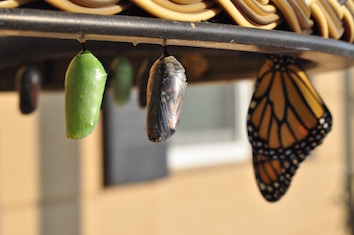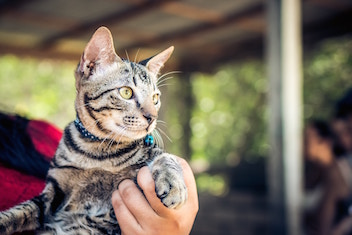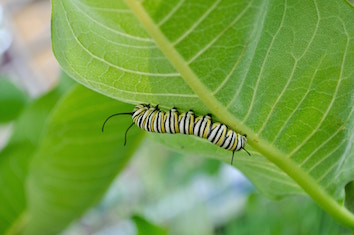
There are a couple of ‘rules’ about pronouns: a pronoun must always follow its antecedent, and agree with it in number. Like so many things in grammar, there are some occasions when it is fine, even necessary, to break the rule but, on the whole, it is a good rule to follow and will generally make your writing easier to understand.
Of course, first you need to know what is meant by an antecedent! And that’s quite simple: the antecedent is simply the noun that the pronoun is replacing. Antecedent literally means [the thing] coming before. It essentially has the same meaning as precedent; it’s just for some reason, lawyers use the word precedent and grammarians use antecedent.
A pronouns must always follow its antedecent
The rule about a pronoun needing to follow its antecedent makes perfect sense. Since the function of a pronoun is to replace a noun, the noun that is being replaced must come first, otherwise we don’t know what the pronoun is referring to. For example:
- A caterpillar looks nothing like the butterfly it will become.
- It looks nothing like the butterfly a caterpillar will become.
The sentence makes no sense when we swap the places of the pronoun (it) and its antecdent (a caterpillar). Similarly, most sentences become hard to understand when we cannot tell what noun a pronoun refers to.
Generally, a pronoun should follow its antecedent as closely as possible for clarity. Again , the reason is quite simple: if there are several nouns, it becomes hard for the reader to tell which noun the pronoun refers to. In some cases, this can cause different meanings. For example:
- To stop the cat from chasing the child’s pet lizard, a bell was put around its neck.
What noun is its referring to? The cat? The pet lizard? The child? Commonsense tells us the bell was most likely put around the cat’s neck but the technical antecedent is actually lizard. In sentences where the pronoun has not been placed as close as possible to its antecedent, the sentence needs to be either rearranged or rewritten to make the meaning clear.
- The cat had a bell put around its neck to stop it from chasing the child’s pet lizard.

If you are writing several paragraphs about the same noun, make sure you start each paragraph with by repeating your noun, rather than using a pronoun.
Butterflies have one of the most interesting life cycles, changing their form completely several times during their life. They begin life as eggs. A caterpillar (technically known as the larva) emerges from the egg and grows until it is ready to for the next stage.
The next stage [not It or This] is to transform into chrysalis or pupa, and the caterpillar [not it] does this inside a cocoon. Finally, the adult butterfly will emerge from the cocoon and find a mate: eggs will be laid and the cycle begins again.

A pronoun must agree in number with its antecedent
The second rule about pronouns, that they must agree in number with their antecedents, also makes perfect sense. If a pronoun is referring back to a singular noun, it needs to be singular; it the pronoun refers to a plural noun, the pronoun also needs to be plural. Look at the confusion that arises when this rule is not followed:
- To stop the cat from chasing the child’s pet lizard, a bell was put around their neck.
- The second rule about pronouns, that it must agree in number with its antecedent, also makes perfect sense.
With the pronoun in the first example being plural, it now sounds like both the lizard and the cat have bells on – and it looks like neck is a mistake (and should be necks). In the second example, the use of a singular pronoun makes us think (before we read on) that it refers to the second rule and not to pronouns (the reference to antecedents then makes it clear that pronouns is what was meant).
When pronouns need not follow their antecedents
Sometimes, a writer wants to create a sense of mystery or drama, and this can be done by using pronouns that don’t have an antecedent: the noun that should be the antecedent will often be used later.
He was an old man who fished alone in a skiff in the Gulf Stream and he had gone eighty-four days now without taking a fish. – Ernest Hemingway, opening sentence of The Old Man and the Sea
She waited, Kate Croy, for her father to come in, but he kept her unconscionably, and there were moments at which she showed herself, in the glass over the mantel, a face positively pale with the irritation that had brought her to the point of going away without sight of him. – Henry James, opening sentence of The Wings of the Dove
He – for there could be no doubt of his sex, though the fashion of the time did something to disguise it – was in the act of slicing at the head of a Moor which swung from the rafters. – Virginia Woolf, opening sentence of Orlando
He was an inch, perhaps two, under six feet, powerfully built, and he advanced straight at you with a slight stoop of the shoulders, head forward, and a fixed from-under stare which made you think of a charging bull. – Joseph Conrad, opening sentence of Lord Jim
But you do need to be aware of what you are doing when you deliberately begin with a pronoun.
The special case of it
It is a pronoun with a special function: it is often used to introduce sentences of a particular structure (often before the verb to be: It is, It was) where it is known as a dummy subject. It is perfectly fine to start a sentence with It, when it is not referring to a particular preceding noun. It is simply a way of getting these particular sentences started. The It that starts each of the previous two sentences does not refer to an antecedent, and the sentences still make perfect sense. I will look at dummy subjects again when I discuss sentence structure, later this year.

If you have found this post interesting, you can find a full index to my other posts on the index page. To be notified when I post a new topic, follow me on Facebook! If you have any particular questions you’d like me to answer in future posts, just send me a message. I’m always interested to learn what people think, and how you came across this site, so please post a comment.
If you think you would be interested in either my complete grammar course or an individual customised online course (particularly suited for people who don’t live in Melbourne), just click your preferred option.
Photos: cocoons by Suzanne D. Williams, caterpillar by Sara Codair, cat by Artem Bali, all on Unsplash
5 comments on “Pronouns – and their antecedents”